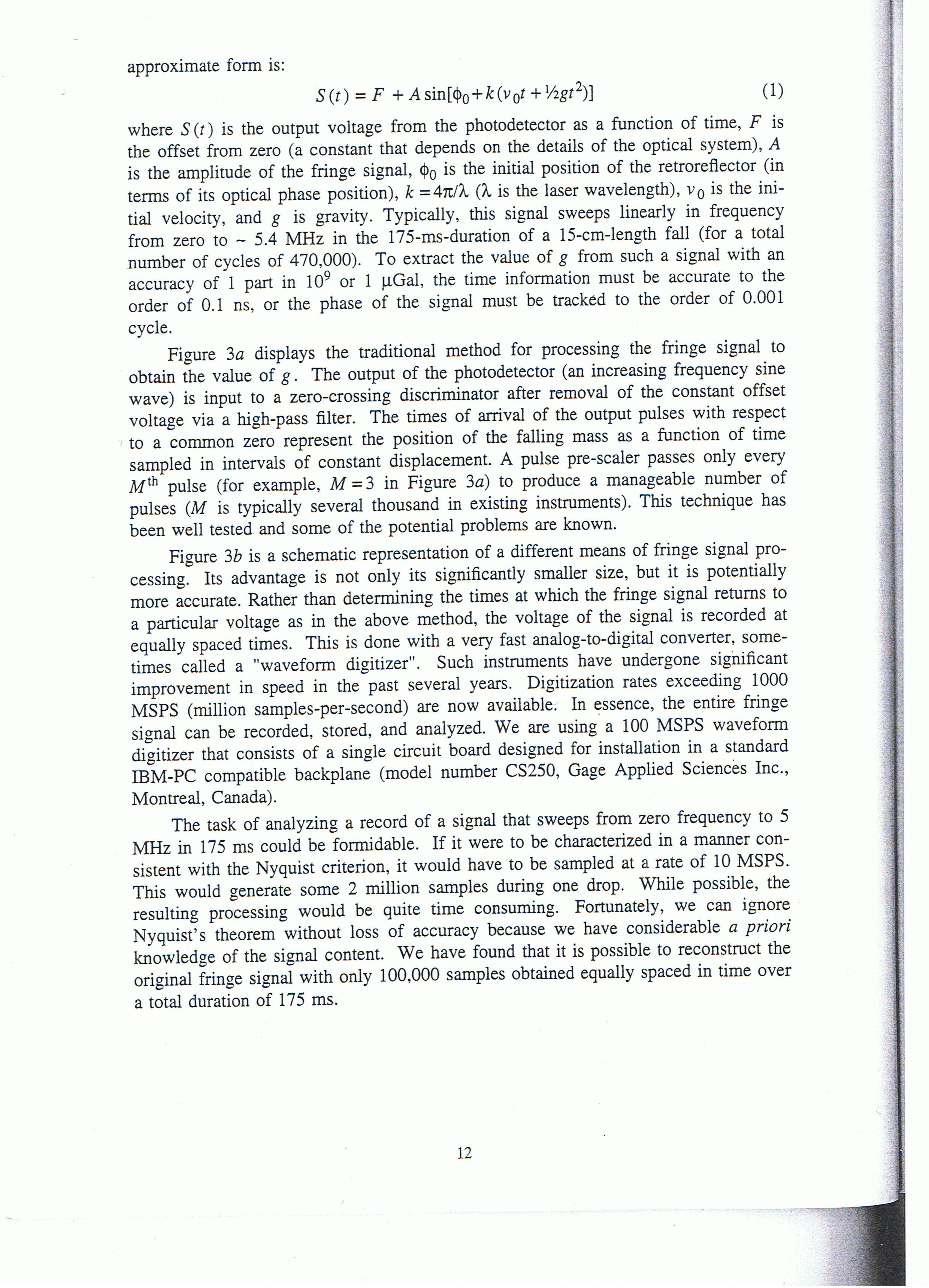CCF20100310�007

approximate form is:
S(t) = F + A sin[<j)0 + fc(v0r + x/igt2)] (1)
where S(r) is the output voltage from the photodetector as a function of time, F is the offset from zero (a constant that depends on the details of the optical system), A is the amplitudę of the fringe signal, <j>0 is the initial position of the retrorefiector (in terms of its optical phase position), k = 4n/k (k is the laser wavelength), v0 is the initial velocity, and g is gravity. Typically, this signal sweeps linearly in freąuency from zero to ~ 5.4 MHz in the 175-ms-duration of a 15-cm-length fali (for a total number of cycles of 470,000). To extract the value of g from such a signal with an accuracy of 1 part in 109 or 1 |iGal, the time information must be accurate to the order of 0.1 ns, or the phase of the signal must be tracked to the order of 0.001 cycle.
Figurę 3a displays the traditional method for processing the fringe signal to obtain the value of g. The output of the photodetector (an increasing freąuency sine wave) is input to a zero-crossing discriminator after removal of the constant offset voltage via a high-pass filter. The times of arrival of the output pulses with respect to a common zero represent the position of the falling mass as a function of time sampled in intervais of constant displacement. A pulse pre-scaler passes only every Mth pulse (for example, M= 3 in Figurę 3a) to produce a manageable number of pulses (M is typically several thousand in existing instruments). This techniąue has been well tested and some of the potential problems are known.
Figurę 3b is a schematic representation of a different means of fringe signal processing. Its advantage is not only its significantly smaller size, but it is potentially morę accurate. Rather than determining the times at which the fringe signal retums to a particular voltage as in the above method, the voltage of the signal is recorded at eąually spaced times. This is done with a very fast analog-to-digital converter, some-times called a "waveform digitizer". Such instruments have undergone significant improvement in speed in the past several years. Digitization rates exceeding 1000 MSPS (million samples-per-second) are now available. In essence, the entire fringe signal can be recorded, stored, and analyzed. We are using a 100 MSPS waveform digitizer that consists of a single circuit board designed for installation in a standard IBM-PC compatible backplane (model number CS250, Gage Applied Sciences Inc., Montreal, Canada).
The task of analyzing a record of a signal that sweeps from zero freąuency to 5 MHz in 175 ms could be formidable. If it were to be characterized in a manner con-sistent with the Nyąuist criterion, it would have to be sampled at a ratę of 10 MSPS. This would generate some 2 million samples during one drop. While possible, the resulting processing would be ąuite time consuming. Fortunately, we can ignore Nyąuist’s theorem without loss of accuracy because we have considerable a priori knowledge of the signal content. We have found that it is possible to reconstruct the original fringe signal with only 100,000 samples obtained eąually spaced in time over a total duration of 175 ms.
12
Wyszukiwarka
Podobne podstrony:
Rei_i/Nce General Insurance GROUP PERSONAL ACCIDENT CLAIM INTIMATION FORM Issuance ofthis form is no
TWO DIFFERENT STATE OF MOBILE SCENE This is the functional character of the mobile scene. In this fo
Agnieszka KRAWCZYK-SOŁTYS not well-ordered form) is problematic not only for public hospitals in Pol
htdctmw 024 THE POWER OF- PERSPECTIWE! Just as FORM is all-important in making an object look real,
CCF20100122�005 JjębdM cpujpoLsOi iS tTtdhdi ? i<s CUupozry cycAouOcsCjy muj ronccol 6’o£?<p
CCF20130224�004 Używając form trybu przypuszczającego Konjunktiv II, możemy wyrazić uprzejmiej prośb
CCF20150916�006 (2) URSIDAEBrown Bear (Ursus arctos) - Holarktyka - 390 kg - its r
CCF20150916�009 (2) Tu:IL ’ V O ^ &-IS u^ o; Cr sO lA - C^ j — /v->. ęJyl
CCF20110129�054 Analityczne zastosowania /l/IS a) Metodą AAS można oznaczać główni
CCF20120108�006 wszystkich form, w których zachodzi taka -wymiana /pór. san- // ::n-u ~ za wariant g
31 (261) 3nstrurtimta for dattimt As will be judgcd, thc simplest form of tatting is the ring which
CCF20100216�004 12 English Phonetics and Phonology ii) In making the two vowels described above, it
CCF20110611�016 What are the 3 stages of evaiuation Nevślle Grant recommands? Oeflne each briefiy. 8
CCF20130224�002 ZAPAMIĘTAJ! Form Konjunktiv II utworzonych jak wyżej używamy dla: r
431525 01 LESSON/ THE HEAD The head is the most freąuently used and also the simplest form in cartoo
lin’s avcraging procedurę in the variational form is used so as to derive the one-dimensionai govemi
General discussion We look for piane wave Solutions of the form e-y-r, in which y is the complex vec
więcej podobnych podstron